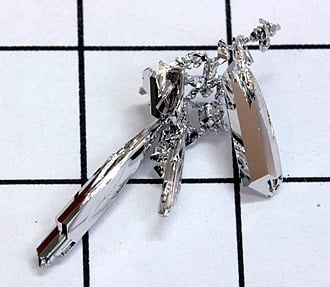Ruthenium

Ruthenium is a chemical element with the symbol Ru and atomic number 44. It is a rare transition metal belonging to the platinum group of the periodic table. Like the other metals of the platinum group, ruthenium is inert to most other chemicals. Russian-born scientist of Baltic-German ancestry Karl Ernst Claus discovered the element in 1844 at Kazan State University and named ruthenium in honor of Russia.[a]
Ruthenium is usually found as a minor component of platinum ores; the annual production has risen from about 19 tonnes in 2009[6] to some 35.5 tonnes in 2017.[7] Most ruthenium produced is used in wear-resistant electrical contacts and thick-film resistors. A minor application for ruthenium is in platinum alloys and as a chemistry catalyst. A new application of ruthenium is as the capping layer for extreme ultraviolet photomasks.
Ruthenium is generally found in ores with the other platinum group metals in the Ural Mountains and in North and South America. Small but commercially important quantities are also found in pentlandite extracted from Sudbury, Ontario and in pyroxenite deposits in South Africa.
Whereas all other group 8 elements have two electrons in the outermost shell, in ruthenium, the outermost shell has only one electron (the final electron is in a lower shell). This anomaly is observed in the neighboring metals niobium (41), molybdenum (42), and rhodium (45).
Ruthenium has four crystal modifications and does not tarnish at ambient conditions; it oxidizes upon heating to 800 °C (1,070 K). Ruthenium dissolves in fused alkalis to give ruthenates (RuO2−
4), is not attacked by acids (even aqua regia) but is attacked by halogens at high temperatures.[8] Indeed, ruthenium is most readily attacked by oxidizing agents.[9] Small amounts of ruthenium can increase the hardness of platinum and palladium. The corrosion resistance of titanium is increased markedly by the addition of a small amount of ruthenium.[8] The metal can be plated by electroplating and by thermal decomposition. A ruthenium-molybdenum alloy is known to be superconductive at temperatures below 10.6 K.[8] Ruthenium is the only 4d transition metal that can assume the group oxidation state +8, and even then it is less stable there than the heavier congener osmium: this is the first group from the left of the table where the second and third-row transition metals display notable differences in chemical behavior. Like iron but unlike osmium, ruthenium can form aqueous cations in its lower oxidation states of +2 and +3.
